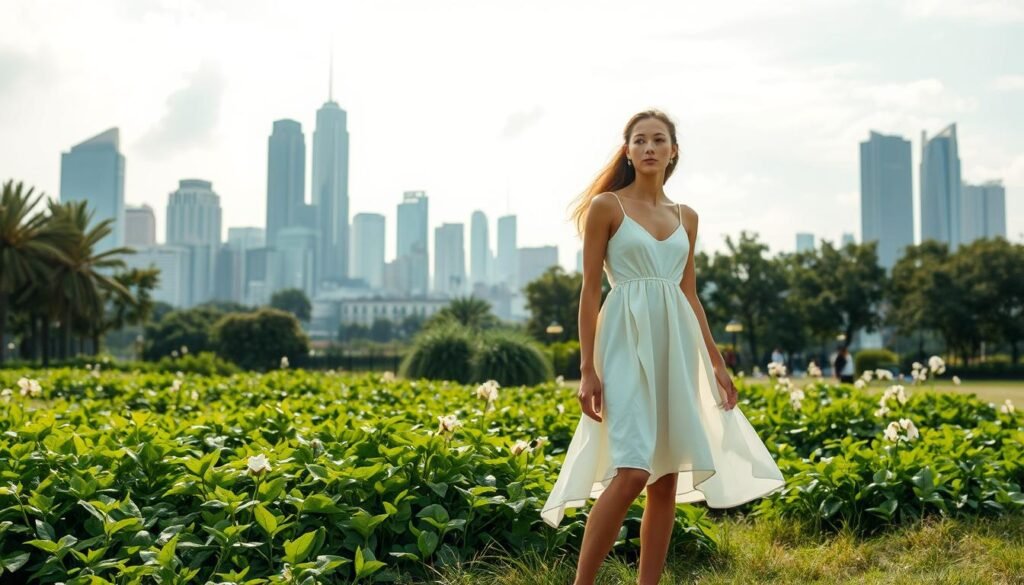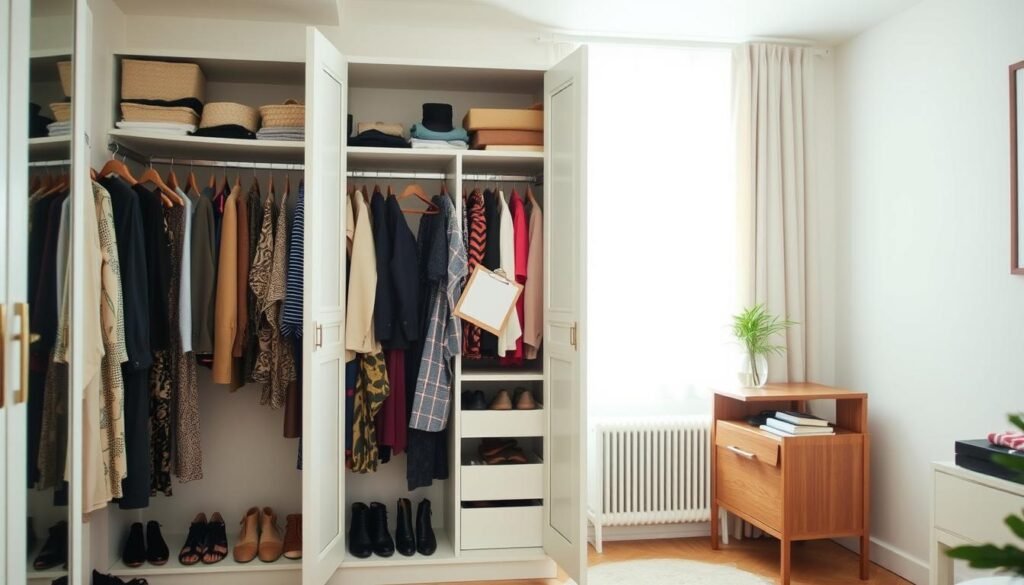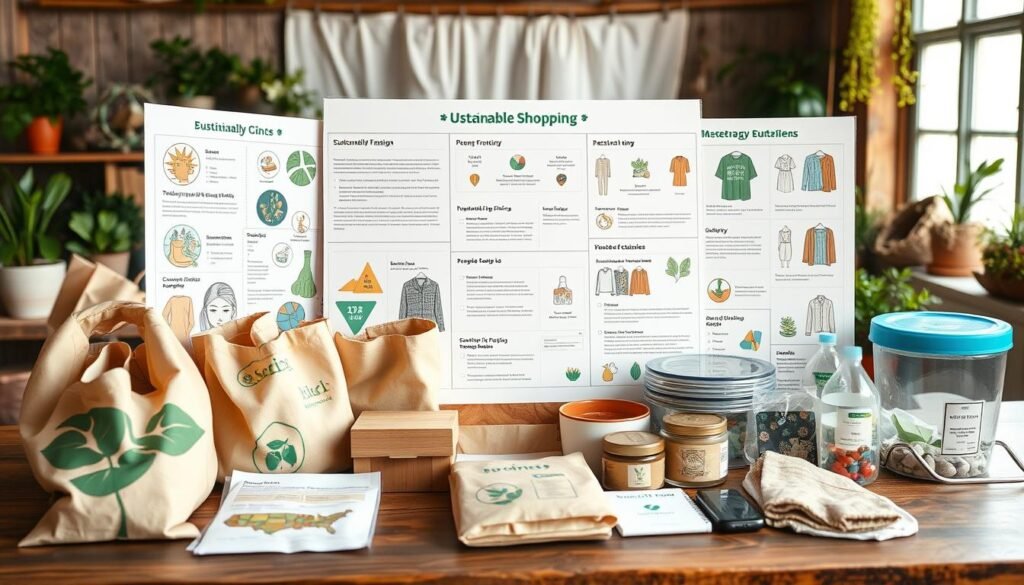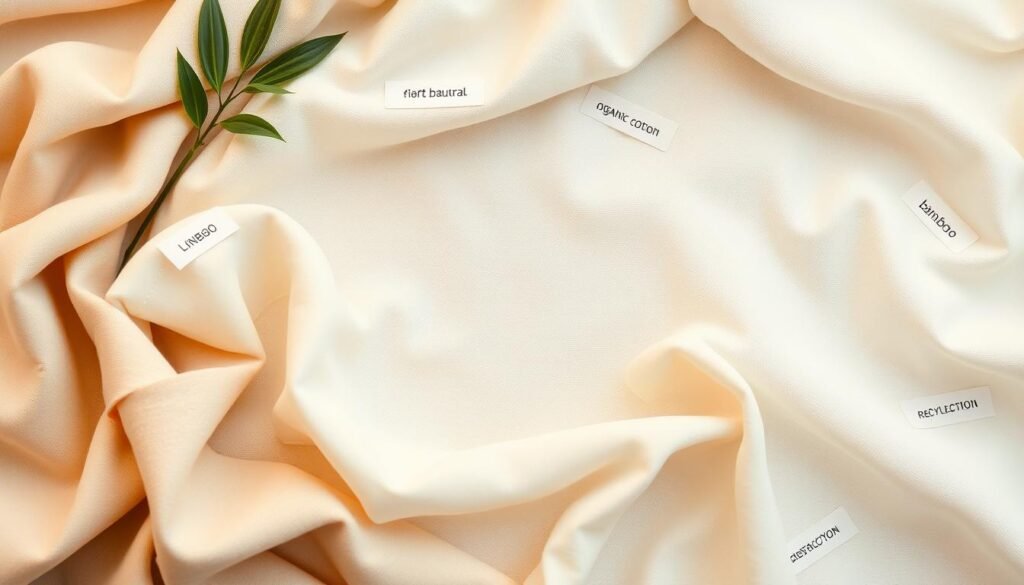“The greatest threat to our planet is the belief that someone else will save it,” said environmentalist Robert Swan. This truth is very relevant to our closets and shopping habits.
The fashion industry has a huge environmental impact. In 2023, it produced 92 million tons of waste and was responsible for 10% of global carbon emissions. These numbers show why making ethical fashion choices is more important than ever.
Sustainable fashion is more than just a trend. It’s about making choices that care for our planet and our health. It’s based on the idea of meeting our needs today without harming future generations.
Many think eco-friendly clothing means giving up style. But that’s not true today. Green fashion now offers both style and environmental responsibility. You don’t need to be perfect to make a difference. Just make smarter choices that help everyone.
Key Takeaways
- The fashion industry produces 92 million tons of waste annually and accounts for 10% of global carbon emissions
- Sustainable fashion focuses on intentional purchasing decisions that benefit both planet and personal well-being
- Eco-friendly clothing options no longer require sacrificing style or aesthetic appeal
- Making ethical fashion choices doesn’t demand perfection – small, smart decisions create meaningful impact
- Green fashion builds on sustainable development principles of meeting present needs without compromising future generations
- Environmental responsibility and stylish wardrobes can coexist in modern sustainable fashion approaches
Understanding What Makes Fashion Truly Sustainable

Real sustainable fashion is more than just trendy labels. It’s a complete change in how we make, use, and throw away clothes. Many brands say they’re eco-friendly but don’t really change their ways.
The fashion world needs to think about its impact on the planet and people. It should care for the environment and treat workers and animals well. We need to stop making so much and using so much.
Defining Sustainable Fashion Beyond Marketing Terms
Authentic sustainable fashion wants big changes in the industry. Experts talk about degrowth and circular economy as key solutions. These ideas question the fast fashion model that values more over better.
But, many companies just pretend to be green. They say they’re making responsible fashion but keep doing harm. No one is fully sustainable yet, but we can make progress by making smart choices.
Environmental Impact of Traditional Fashion Industry
The old fashion way harms the planet and pollutes. It makes a lot of waste and uses bad chemicals. It also uses a lot of water and pollutes it.
Eco-conscious fashion tries to fix these problems. It uses better materials and cleaner ways to make clothes. It also tries to waste less by designing and making clothes better.
Social Responsibility in Clothing Production
Sustainability also means treating workers right. Many garment workers are exploited, paid little, and work in bad conditions. Ethical clothing makes sure workers are paid fairly and work in safe places.
| Sustainability Aspect | Traditional Fashion | Sustainable Fashion |
|---|---|---|
| Production Model | Fast, high-volume | Quality-focused, limited quantities |
| Worker Treatment | Low wages, poor conditions | Fair wages, safe environments |
| Environmental Impact | High pollution, waste | Minimal footprint, circular processes |
| Material Sourcing | Cheap, synthetic materials | Organic, recycled, renewable fibers |
Knowing these points helps us choose better. While perfect sustainability is hard, supporting good brands helps change the industry for the better.
Step 1: Audit Your Current Wardrobe

The journey to eco-friendly style starts with checking what you already have. This first step helps you buy less and use more of what you own. A detailed wardrobe audit uncovers hidden treasures and shows what’s missing in your closet.
“The most sustainable garment is the one already in your closet.”
Many face the “nothing to wear” problem, even with full closets. This is because we forget what we have and make hasty buys instead of careful choices.
Conducting a Complete Assessment
Begin your closet assessment by taking everything out. Sort items into four piles: keep, donate, repair, and replace. This approach helps you stay focused and ensures nothing is missed.
Try on items you’re unsure about to see how they fit and feel. Clothes often look different on you than they do on a hanger. Be truthful about what you really wear versus what you think you should.
Deciding What Stays and What Goes
Keep items that fit well, make you feel good, and fit your lifestyle. Replace anything that’s too worn, doesn’t fit, or hasn’t been worn in over a year. Think about how versatile each piece is and how it goes with other clothes.
Donate items that are in good shape but no longer fit you. This extends their life and helps others build a sustainable wardrobe.
Understanding Cost-Per-Wear Value
Figure out the cost-per-wear by dividing the original price by how many times you’ve worn it. For example, a $200 coat worn 100 times costs $2 per wear. On the other hand, a $50 shirt worn twice costs $25 per wear.
This method shows which items are truly worth it. It helps you make better choices when buying new clothes, focusing on quality over quantity.
Step 2: Research and Identify Ethical Fashion Brands

The fashion world is full of brands claiming to be sustainable. But, it’s hard to tell the real ones from the fake ones. With a 71% rise in searches for sustainable goods in five years, people want to know who’s really eco-friendly. It’s all about knowing what to look for and where to find the truth.
Amy Powney from Mother of Pearl says research and asking questions are key. Social media lets you talk directly to brands about their green efforts. If you can’t find a brand’s eco-credentials, they might not be as green as they say.
Essential Sustainability Certifications to Look For
Real sustainable fashion brands show third-party certifications. GOTS (Global Organic Textile Standard) checks if fibers are organic and if the process is eco-friendly. OEKO-TEX makes sure textiles are safe from harmful stuff.
Fair Trade certification means workers get fair pay and good working conditions. B-Corp status shows a company is serious about being good for the planet and people. These signs prove a brand is serious about making clothes the right way.
How to Verify Brand Claims and Transparency
Good eco-friendly brands share lots of info about their supply chains and how they treat workers and the planet. Look for sustainability reports and transparency pages on their websites. These show their goals and what they’ve achieved.
Use sites like Good On You to check how brands rate on people, planet, and animals. They give scores from “We Avoid” to “Great.” If a brand is secretive or vague, it’s a warning sign.
Top Sustainable Fashion Brands by Category
For everyday clothes, Patagonia, Eileen Fisher, and Kotn are top choices. In activewear, Girlfriend Collective and Outdoor Voices stand out for using recycled materials and making clothes right.
For fancy clothes, Reformation and Amour Vert are great. They’re known for being green and open. Accessory brands like Matt & Nat (vegan bags) and Rothy’s (recycled shoes) offer cool, eco-friendly choices. These brands show you can look good and do good at the same time.
Step 3: Master the Art of Sustainable Fashion Shopping

Changing your fashion choices for good needs more than just wanting to. It requires a smart shopping plan. Sustainable shopping turns quick buys into careful choices that help your clothes and the planet. This way, you build a wardrobe you’ll love for years, all while being kinder to the earth.
Switching from fast fashion to mindful fashion consumption is a journey. But with the right steps, shopping green will become second nature to you.
Creating Your Sustainable Shopping Strategy
Your sustainable shopping plan should match your life, budget, and values. First, look at what’s missing in your closet. Make a list of must-haves, focusing on the essentials.
Don’t rush to buy everything at once. Take your time to find the right pieces. Decide what matters most to you, like eco-friendly labels or supporting certain causes.
Questions to Ask Before Every Purchase
The 30 Wears Challenge by Livia Firth and Lucy Seigle taught us to think hard before buying. Now, aim for pieces you’ll wear forever, not just 30 times.
Before buying, ask yourself these questions:
- Can I style this piece at least five different ways?
- Will this look good in five years?
- Does this really fill a wardrobe gap?
- Do I already have something like this?
Setting and Sticking to Your Quality Budget
Eco-conscious shopping might mean spending more upfront, but it saves money in the long run. Compare the cost of quality items to cheaper ones to see the real value.
Save money each month for sustainable buys. This way, you won’t be tempted to buy cheap things when you need something fast.
Best Times and Places to Shop Sustainably
Shopping smart means buying at the right times. Look for sales at the end of seasons and sign up for newsletters for deals.
Check out online stores and local boutiques that focus on green fashion. They often share how they’re making a difference, making it easier to choose wisely.
Changing your shopping habits takes time. Be kind to yourself as you learn and celebrate your small wins.
Step 4: Choose Eco-Friendly Materials and Fabrics

The materials in your clothes impact the ocean and soil quality. Knowing what’s in your clothes is key for eco-friendly style. This knowledge helps you choose clothes that are good for you and the planet.
Understanding labels makes choosing the right materials easier. Sustainable fabrics are often softer and last longer than others.
Natural Fiber Champions
Organic cotton is a top choice because it avoids harmful pesticides. This helps keep water and soil clean for farmers.
Linen uses less water and gets softer with each wash. Hemp improves soil quality and gets softer too.
Bamboo fabric is soft and has natural antibacterial properties. But, choose mechanically processed bamboo for true sustainability.
Next-Generation Materials
Recycled polyester turns plastic bottles into fabric, reducing waste. Tencel, made from wood pulp, is silky and biodegradable.
New materials like Piñatex and mushroom leather show sustainable fashion doesn’t mean giving up style or function.
Materials That Harm
Conventional polyester and nylon release microplastics when washed. These harm our food and water.
Regular cotton uses a lot of water and pesticides. Acrylic fabrics pollute the air and don’t break down.
When buying ethical clothing, check the fabric first. Even small changes help the environment a lot over time.
Step 5: Build Your Sustainable Fashion Capsule Wardrobe
Creating a capsule wardrobe solves the “nothing to wear” problem. It also supports your goal of sustainable fashion. Your closet becomes a collection of carefully chosen pieces that go well together.
A good capsule wardrobe has 20-30 quality items. These items can make many different outfits. Fewer, better choices actually give you more styling options.
“The secret of getting ahead is getting started. The secret of getting started is breaking your complex overwhelming tasks into small manageable tasks, and starting on the first one.”
Planning Your Essential Wardrobe Foundation
First, think about your lifestyle and style. Consider your daily activities, the weather, and your job. A busy professional might need more blazers and dress pants. A work-from-home parent might prefer comfy knits and jeans.
Your foundation should have timeless basics. Think of well-fitted jeans, classic white shirts, quality blazers, and cozy sweaters. These are the core of your minimalist wardrobe.
Selecting Versatile Pieces That Mix and Match
Choose items that go well together. Use 2-3 neutral colors like black, white, navy, or beige. Then, add 2-3 accent colors that match well.
Look for transitional pieces that work all year and for different occasions. A good cardigan can make a casual outfit look better or add warmth to a summer dress. This way, you get more wear out of your clothes and help the environment.
Make outfit formulas with your pieces. For example, blazer + jeans + white shirt for casual Friday, or blazer + dress pants + blouse for meetings. This makes choosing outfits easier.
Adding Seasonal and Statement Items Strategically
Once your foundation is set, add seasonal and trendy items. Include a cozy winter coat, summer sandals, or a statement necklace. These items should reflect current styles but keep your capsule cohesive.
Sustainable fashion doesn’t mean boring fashion. Let 10-20% of your wardrobe be for pieces that show your personality and keep your style fresh. Choose quality items that you’ll love for years, not just one season.
Building a capsule wardrobe is a journey. Replace worn items with similar ones, and update your collection as your style changes. This way, you stay creative and support the environment.
Step 6: Extend the Lifespan of Your Clothing
Smart care of your clothes can make them last longer. Learning how to take care of your clothes saves money and helps the planet. Keeping clothes in good shape for years is a win for the environment.
Proper Care and Washing Techniques
Good clothing care starts with washing. Washing in cold water saves energy and keeps clothes looking new. Always separate clothes by color and weight to avoid damage.
Use eco-friendly detergents that are kind to clothes and the planet. These detergents keep clothes in good shape without harming the environment. Always check the care labels to keep clothes looking their best.
Steamers are great for getting rid of wrinkles without damaging clothes. They kill bacteria and freshen clothes between wearings. They’re perfect for delicate fabrics that can’t handle ironing.
Storage Solutions to Prevent Damage
Storing clothes right is key to keeping them in good shape. Use padded or wooden hangers to avoid wrinkles and snags. Cedar blocks keep moths away and make your closet smell nice.
Don’t overcrowd your closet to avoid wrinkles and stress on clothes. Fold sweaters instead of hanging them to prevent stretching. Store out-of-season clothes in breathable bags to keep them dust-free.
Simple Repair and Alteration Methods
Knowing how to fix clothes makes you a ethical clothing hero. Learn to sew on buttons, mend tears, and hem clothes yourself. These skills can save many clothes from being thrown away too soon.
Use fabric shavers to remove pilling from clothes, making them look new again. For bigger changes, get professional help. It’s cheaper than buying new clothes. Every repair helps reduce waste and saves resources.
Step 7: Explore Alternative Sustainable Fashion Sources
The world of alternative fashion sources opens doors to unique finds while supporting environmental responsibility. These creative shopping methods offer exciting ways to build an eco-friendly style. You’ll discover one-of-a-kind pieces that traditional retail simply cannot match.
With 300,000 tonnes of unwanted clothes discarded annually instead of being recycled, exploring these alternatives is a style adventure and an environmental necessity. Each purchase from alternative sources helps extend garment lifecycles and reduces fashion waste.
Mastering Thrift Store and Consignment Shopping
Thrift shopping requires strategy and patience, but rewards come in the form of incredible deals and unique discoveries. Visit stores regularly, as inventory changes frequently. Tuesday through Thursday mornings often offer the best selection before weekend shoppers arrive.
Inspect items carefully for quality indicators like sturdy seams, natural fabrics, and minimal wear. Online platforms like Vestiaire Collective, The RealReal, and 1stDibs provide authenticated luxury second-hand fashion with detailed condition reports and return policies.
Clothing Rental and Subscription Services
Clothing rental services support circular economy principles by maximizing each garment’s usage across multiple consumers. These platforms work perfectly for special occasions, trend experimentation, or professional wardrobes without long-term commitment.
Popular rental services offer everything from designer gowns to everyday workwear. This approach reduces individual clothing consumption while providing access to high-quality, frequently updated fashion selections.
DIY Upcycling and Customization Projects
Transform tired pieces into unique statement items through simple DIY techniques. Embroidery, fabric dyeing, and strategic cutting can breathe new life into worn garments while expressing personal creativity.
Start with beginner-friendly projects like adding patches or changing buttons. More advanced techniques include garment reconstruction and combining multiple pieces. Clothing swap parties within communities create social, sustainable opportunities to refresh wardrobes while building connections with like-minded fashion enthusiasts.
These alternative sources make sustainable fashion feel adventurous instead of restrictive. They prove that second-hand fashion and creative approaches often yield the most memorable and meaningful wardrobe additions.
Your Sustainable Fashion Journey Starts Today
Creating an eco-friendly style is a journey, not a quick fix. Every small step you take helps your wardrobe and the planet. This guide offers seven steps to help you, whether you’re just starting or looking to improve.
The future of sustainable fashion is bright. More brands now focus on ethical clothing, giving you many stylish options that match your values. You don’t have to choose between looking good and doing good anymore.
Begin with a simple action today. Check your closet, research a sustainable brand, or learn how to care for your clothes. These small steps add up to big changes that help everyone.
Your choices have a big impact. Every time you buy something sustainable, you send a message to the fashion world. By choosing quality over quantity, supporting ethical brands, or making your clothes last longer, you’re part of a movement changing fashion.
Don’t worry if you’re not perfect. Sustainable style is about making better choices that show you care about your style and the planet. Your journey to more conscious fashion starts with your next decision.
FAQ
Is sustainable fashion really more expensive than fast fashion?
Is sustainable fashion really more expensive than fast fashion?
FAQ
Is sustainable fashion really more expensive than fast fashion?
Sustainable fashion might cost more upfront. But, it offers better value over time. A 0 piece of ethical clothing worn 100 times costs just
FAQ
Is sustainable fashion really more expensive than fast fashion?
Sustainable fashion might cost more upfront. But, it offers better value over time. A $100 piece of ethical clothing worn 100 times costs just $1 per wear. In contrast, a $20 fast fashion item worn 10 times costs $2 per wear.
Eco-friendly style focuses on durable, long-lasting pieces. This approach is better than buying cheap, disposable clothes.
How can I tell if a brand is genuinely sustainable or just greenwashing?
Look for specific certifications like GOTS, OEKO-TEX, Fair Trade, or B-Corp status. Real sustainable fashion brands share detailed info about their practices. They talk about their supply chain, labor, and environmental impact.
Be cautious of vague claims like “eco-friendly” without proof. Use tools like Good On You to check brand ratings. They consider people, planet, and animal welfare.
What are the most sustainable fabric choices for clothing?
Choose organic cotton, linen, hemp, and innovative materials like Tencel. Tencel comes from sustainably sourced wood pulp. Recycled polyester and mushroom leather are also green fashion leaders.
Avoid conventional polyester, nylon, and acrylic. They harm the environment with microplastic pollution.
How many items should be in a sustainable capsule wardrobe?
Aim for 20-30 pieces in your sustainable wardrobe. These should be quality basics like jeans, white shirts, and blazers. The goal is to create many outfits with these versatile items.
Choose items that can be mixed and matched. Focus on colors and styles that work well together.
Can I build a sustainable wardrobe on a tight budget?
Yes, you can! Start by sorting through what you already have. Then, shop at thrift stores, swap clothes with friends, and look for sales from ethical brands.
Invest in quality pieces over time. Caring for your clothes properly is also budget-friendly.
How do I properly care for sustainable fabrics to make them last longer?
Wash sustainable fabrics in cold water with eco-friendly detergents. Air-dry them when you can. Use steamers for gentle wrinkle removal and to kill bacteria.
Store clothes with cedar blocks to keep moths away. Use the right hangers to keep shapes. Learn basic repair skills to extend your clothes’ life.
What’s the environmental impact of the traditional fashion industry?
The fashion industry is huge, producing 92 million tons of waste yearly. It’s responsible for 10% of global carbon emissions. Every year, 300,000 tonnes of clothes are thrown away instead of recycled.
Traditional fashion also pollutes water, uses too many pesticides, and exploits workers. Sustainable fashion aims to fix these problems through ethical production and recycling.
Are clothing rental services a good sustainable option?
Yes, they are! Clothing rental services help reduce waste by letting many people wear the same clothes. They’re great for special occasions or trying out new styles without buying.
Rental services offer everything from designer dresses to workwear. They make sustainable fashion more accessible and reduce the need for owning many clothes.
How can I start shopping more sustainably without completely changing my style?
Start by finding sustainable brands that match your style. Look for ethical alternatives to your favorite items. Gradually replace old clothes with new, sustainable ones.
Use the 30-wears test before buying. Ask yourself if you’ll wear an item at least 30 times. Sustainable fashion doesn’t mean giving up your style.
What should I do with clothes I no longer want during my wardrobe audit?
Sort items into keep, donate, repair, and replace piles. Donate good items to charity shops or consignment stores. Swap clothes with friends or community groups.
Fix minor repairs yourself to extend your clothes’ life. For damaged items beyond repair, look for textile recycling programs. This supports sustainable fashion principles.
per wear. In contrast, a fast fashion item worn 10 times costs per wear.
Eco-friendly style focuses on durable, long-lasting pieces. This approach is better than buying cheap, disposable clothes.
How can I tell if a brand is genuinely sustainable or just greenwashing?
Look for specific certifications like GOTS, OEKO-TEX, Fair Trade, or B-Corp status. Real sustainable fashion brands share detailed info about their practices. They talk about their supply chain, labor, and environmental impact.
Be cautious of vague claims like “eco-friendly” without proof. Use tools like Good On You to check brand ratings. They consider people, planet, and animal welfare.
What are the most sustainable fabric choices for clothing?
Choose organic cotton, linen, hemp, and innovative materials like Tencel. Tencel comes from sustainably sourced wood pulp. Recycled polyester and mushroom leather are also green fashion leaders.
Avoid conventional polyester, nylon, and acrylic. They harm the environment with microplastic pollution.
How many items should be in a sustainable capsule wardrobe?
Aim for 20-30 pieces in your sustainable wardrobe. These should be quality basics like jeans, white shirts, and blazers. The goal is to create many outfits with these versatile items.
Choose items that can be mixed and matched. Focus on colors and styles that work well together.
Can I build a sustainable wardrobe on a tight budget?
Yes, you can! Start by sorting through what you already have. Then, shop at thrift stores, swap clothes with friends, and look for sales from ethical brands.
Invest in quality pieces over time. Caring for your clothes properly is also budget-friendly.
How do I properly care for sustainable fabrics to make them last longer?
Wash sustainable fabrics in cold water with eco-friendly detergents. Air-dry them when you can. Use steamers for gentle wrinkle removal and to kill bacteria.
Store clothes with cedar blocks to keep moths away. Use the right hangers to keep shapes. Learn basic repair skills to extend your clothes’ life.
What’s the environmental impact of the traditional fashion industry?
The fashion industry is huge, producing 92 million tons of waste yearly. It’s responsible for 10% of global carbon emissions. Every year, 300,000 tonnes of clothes are thrown away instead of recycled.
Traditional fashion also pollutes water, uses too many pesticides, and exploits workers. Sustainable fashion aims to fix these problems through ethical production and recycling.
Are clothing rental services a good sustainable option?
Yes, they are! Clothing rental services help reduce waste by letting many people wear the same clothes. They’re great for special occasions or trying out new styles without buying.
Rental services offer everything from designer dresses to workwear. They make sustainable fashion more accessible and reduce the need for owning many clothes.
How can I start shopping more sustainably without completely changing my style?
Start by finding sustainable brands that match your style. Look for ethical alternatives to your favorite items. Gradually replace old clothes with new, sustainable ones.
Use the 30-wears test before buying. Ask yourself if you’ll wear an item at least 30 times. Sustainable fashion doesn’t mean giving up your style.
What should I do with clothes I no longer want during my wardrobe audit?
Sort items into keep, donate, repair, and replace piles. Donate good items to charity shops or consignment stores. Swap clothes with friends or community groups.
Fix minor repairs yourself to extend your clothes’ life. For damaged items beyond repair, look for textile recycling programs. This supports sustainable fashion principles.

